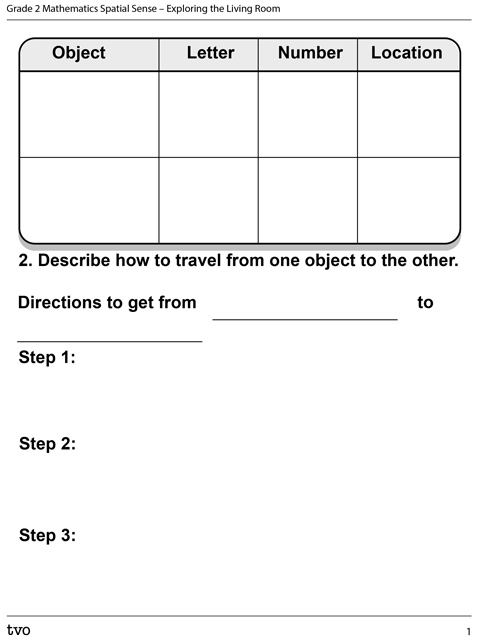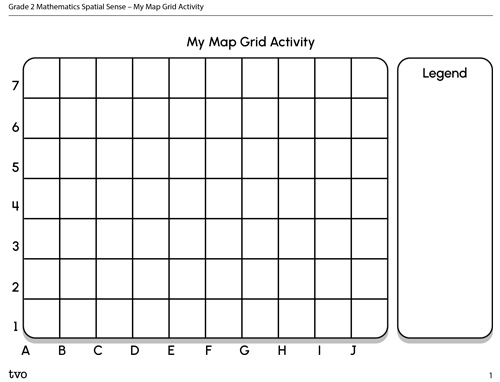Minds On
Explore
Explore the following video entitled “On the Grid” to learn more about interpreting maps and grids.
Brainstorm
Let’s think!
Reflect on the following questions:
- How can a map grid be used?
- How are the numbers and letters used to describe location?
- Why are maps important?
Record your ideas in your notebook or another method of your choice.
Action
Maps and grids

Select the correct answer, then press ‘Check Answer’ to check how you did.
Press ‘Show Results’ to reveal a description about maps.
What is a map used for?
- A map gives us a view of an area.
- A map shows the positions of objects compared to other objects.
How can a grid help to find a location of an object?
- A grid can help us to figure out the distance or route to travel from one object to another.
How do we describe an object on a grid?
- We can use numbers, letters, and words to describe an object on a grid.
Task: Exploring map grids
Let’s explore the following map grid of a living room.
After exploring the living room map grid:
- record the location of 2 of the 4 items using letters and numbers
- describe how to travel from one object to the other
The 4 items are a table, a TV, a couch, and a chair.
Complete the Exploring the Living Room Chart in your notebook or using the following fillable and printable document. You can also use a method of your choice.

Press the Activity button to access the Exploring the Living Room Chart.
Activity (Open PDF in a new tab)Press ‘Show Example’ to reveal sample directions from the couch to the TV.
For example, if you were to give directions from the couch to the TV, the instructions could be:
Step 1: Start at the couch, F7.
Step 2: Move 3 spaces down to get to F4.
Step 3: Move 4 spaces to the right to get to J4.
We are now at the TV!
Create your own map
Let’s create your own map grid of a space or room of your choice.
1. Select 4 items to place on your map grid.
Press ‘Show Example’ to reveal sample objects in a classroom.
For example, if we were to create a grid map of a classroom, a few classroom objects may include:
- student desk
- teacher desk
- bookshelf
- carpet
2. Use symbols to represent your selected objects.
Press ‘Show Example’ to reveal sample objects in a classroom.
For example, if we were to create a grid map of a classroom, a few symbols for classroom objects we can use are:
- a square for a student desk
- an apple for a teacher desk
- a book for a bookshelf
- a circle for a carpet
3. Record what your symbols mean in a legend, like the following example:
Complete the My Map Grid Activity in your notebook or using the following fillable and printable document. You can also use a method of your choice.
Describe it!
Using the map grid you just created, describe the location of the four items using letters, numbers, and words (left, right, up, down, in front of, behind, above, and below).
Student tips
Describe a location
- When describing the location using letters and numbers, the letter comes first, followed by the number
- Include words such as left, right, up, down, in front of, behind, above, and below to describe where each object is, compared to the other objects in the room
Record your ideas in your notebook or another method of your choice.
Consolidation
Time to navigate!

Use the map grid you previously created in the Action section, and describe how to travel from 1 object, to 2 other objects in the space you designed.
Select a starting point and create a set of directions, which can be followed to get from your starting point to 2 other objects.
For example, if I started at the couch and travelled to the chair, and then travelled to the TV, I would need directions from the couch to the chair, and then from the chair to the TV.
Be sure to:
- describe the steps in order using words, numbers, and units
- use words such as: left, right, up, down, in front of, behind, above, and below
Record your ideas in your notebook or another method of your choice.
Making connections
Reflect on the following questions:
- Why is it helpful to understand how to read a map?
- Why is the order of directions important? What would happen if they were in a different order?
Record your ideas in your notebook or another method of your choice.
Reflection
How do you feel about what you have learned in this activity? Which of the next four sentences best matches how you are feeling about your learning? Press the button that is beside this sentence.
I feel...
Now, record your ideas about your feelings using a voice recorder, speech-to-text, or writing tool.
